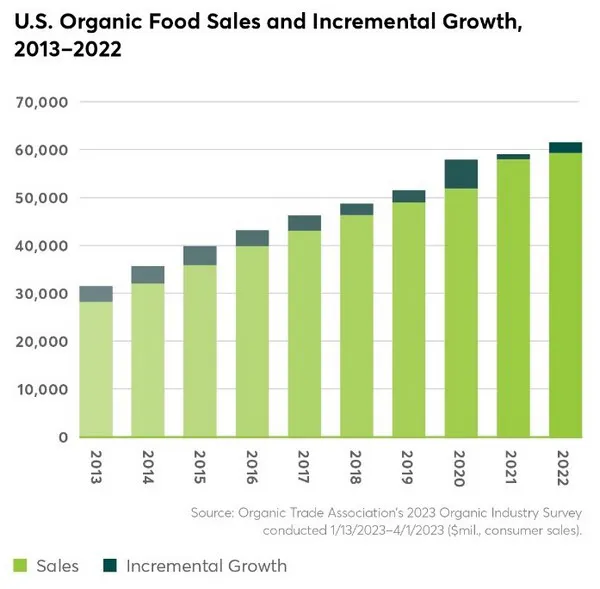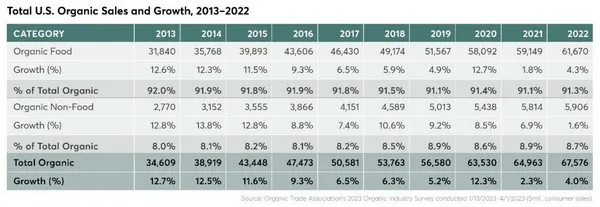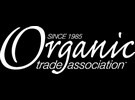Organic food sales in the United States in 2022 broke through $60 billion for the first time, hitting another high-level mark for the resilient organic sector. Total organic sales – including organic non-food products – were a record $67.6 billion*, according to the 2023 Organic Industry Survey released Wednesday by the Organic Trade Association.

The organic market grew despite challenging headwinds: inflation pressures tightening consumer wallets, supply chain disruptions caused by the pandemic and global political events, a proliferation of competing food labels in the grocery aisles, and a labor shortage felt acutely by organic producers. Inflation heated up costs across the organic supply chain – indeed, the entire food supply chain – and boosted prices in the grocery aisles. As a result, the organic sector reflected the overall food sector, with the value of organic sales rising even as the growth in the volume of sales for some categories slipped.
The sector’s four-percent growth in sales value was nearly twice the pace of growth in 2021. Organic food sales totaled $61.7 billion, while the value of organic non-food sales hit nearly $6 billion. Certified Organic now accounts for 6 percent of total food sales in the United States.
“Organic has proven it can withstand short-term economic storms. Despite the fluctuation of any given moment, Americans are still investing in their personal health, and, with increasing interest, in the environment; organic is the answer,” said Organic Trade Association CEO Tom Chapman. “Organic’s fundamental values remain strong, and consumers have demonstrated they will come back time and again because the organic system is verified and better for people, the planet, and the economy.”
Produce still leads organic
Organic produce, often the entry point for new organic buyers, easily held its position as the top seller of all organic categories. Sales of organic produce totaled $22 billion, accounting for 15 percent of all fruit and vegetable sales in this country.
Organic beverages were the second best-selling organic category, reporting $9 billion in sales in 2022, up 4 percent. Organic coffee maintained its position as the biggest-selling organic beverage, up almost 7 percent from the year before, with close to $2.3 billion in sales. Organic soft drinks and enhanced drinks broke through $500 million in sales at $503 million and saw robust growth of almost 14 percent.
“Organic beverages continue to climb. They’re an area where shoppers are willing to experiment and are less price sensitive,” noted Angela Jagiello, Director of Education and Insights for OTA and coordinator of the annual survey. “Soft and enhanced drinks had a great year, with the non-alcoholic trend being a big contributing factor. Many younger shoppers are reducing or eliminating alcohol, and these organic beverages are a celebratory and sophisticated alternative.”
The third highest-selling organic category was dairy and eggs at $7.9 billion, up over 7 percent from the previous year. Organic dairy and eggs now constitute close to 8 percent of the total dairy and egg market. Continued demand and inflationary price increases helped boost the dollar sales in that category; yogurt and eggs both saw double-digit growth, with organic yogurt sales jumping by over 12 percent to $1.5 billion and organic egg sales by 11 percent to around $1.2 billion.
While the growth pace of organic sales has predictably slowed from the barnburner rates during the pandemic, a wide and diverse smattering of organic products showed outstanding growth as consumers bring organic more fully into their lives. To name a few: organic baby food and formula sales are up almost 13 percent to $1.4 billion, sales of organic rice, grains, and potato products are up over 10 percent to $387 million, organic dip sales are up a big 18 percent to $194 million, and sales of organic pork up more than 10 percent to $63 million.
In the organic non-food category, sales of organic linens and clothing accounted for some 40 percent of sales, recording $2.4 billion in sales for a gain of 2.5 percent. Organic supplement sales held steady, with sales of around $2 billion, while organic personal care products rose over 5 percent to $1.2 billion.

Organic future is bright
The success of organic is not a new story. In the last ten years, organic sales have more than doubled as Americans are eating and using more organic products than ever before. Total organic sales broke through the $50 billion mark for the first time in 2018, and organic food sales hit $50 billion for the first time just a few years ago in 2019.
“Organic is at that right intersection of environmental and personal health,” said OTA’s Chapman. “Organic brings together the interest in human health and a healthy environment, and that offers organic a positive pathway forward and will help organic businesses withstand challenges in the future.”
This year’s survey was conducted early in 2023, from January 13 through April 4, and was produced on behalf of the Organic Trade Association by Nutrition Business Journal (NBJ). Numerous data sources were compiled to create as complete a picture as possible of the organic industry, which consists largely of private companies. Inputs include but are not limited to point-of-sale data, expert interviews, annual report data, and in-depth direct survey data. About 100 companies completed a significant proportion of the in-depth survey.
For more information: Organic Trade Association
Organic Trade Association
444 N. Capitol St. NW, Suite 445A
Washington D.C. 20001
Tel.: 202-403-8520
www.ota.com
